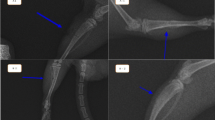Abstract
The effect of magnetic and laser therapy on healing of bone fractures and blood levels of T and B lymphocytes was studied in rats during osteosynthesis by the Ilizarov method. Laser therapy induced changes in cells attesting to stimulation of reparative processes and normalization of immunological parameters.
Similar content being viewed by others
REFERENCES
A. G. Babaeva, in: Ed. D. Sarkisov, Structural Principles of Adaptation and Compensation of Disturbed Functions[in Russian], Moscow (1987), pp. 185-193.
G. I. Lavrishcheva and L. N. Mikhailova, Structural Principles of Adaptation and Compensation of Disturbed Functions, pp. 154-184.
Eds. D. S. Sarkisov and Yu. L. Perov, Microscopic Technique (Practical Manual)[in Russian], Moscow (1996).
D. S. Sarkisov, Essays on General Pathology History[in Russian], Moscow (1993).
D. S. Sarkisov, in: Ed. D. Sarkisov, Structural Principles of Adaptation and Compensation of Disturbed Functions[in Russian], Moscow (1987), pp. 9-83.
Ed. D. B. Apfelberg, Evaluation and Installation of Surgical Laser Systems, New York (1987).
T. Ohshiro and R. G. Calderhead, Low Level Laser Therapy: a Practical Introduction, New York (1988).
Author information
Authors and Affiliations
Rights and permissions
About this article
Cite this article
Baibekov, I.M., Khanapiyaev, U.K. Healing of Bone Fractures of Rat Shin and Some Immunological Indices during Magnetic Laser Therapy and Osteosynthesis by the Ilizarov Method. Bulletin of Experimental Biology and Medicine 131, 399–402 (2001). https://doi.org/10.1023/A:1017933026086
Issue Date:
DOI: https://doi.org/10.1023/A:1017933026086




